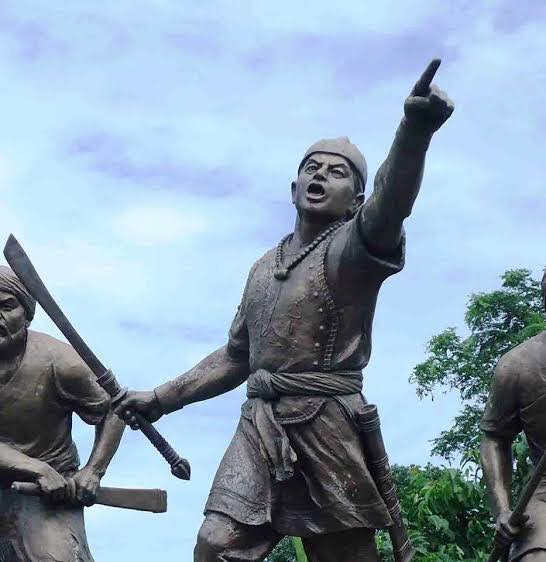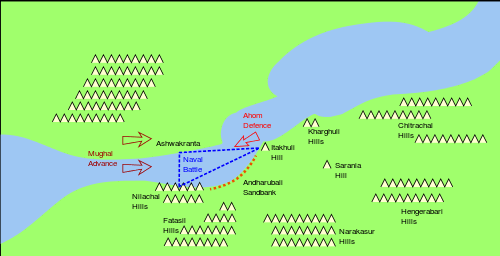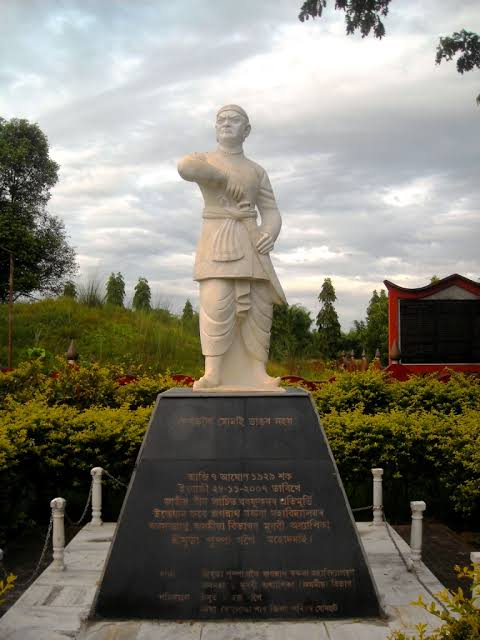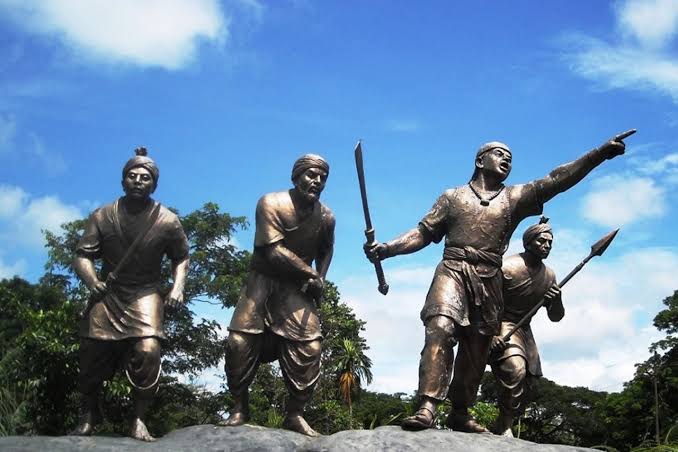THE BATTLE OF SARAIGHAT (1671)
Lachit Borphukan's humiliation of Aurangzeb.
The battle of Saraighat was a naval engagement fought on the Brahmaputra river near Saraighat between the M0ghul empire and Ahom kingdom in 1671.
Guts, resolve and glory!
(Elaborate thread)
Lachit Borphukan's humiliation of Aurangzeb.
The battle of Saraighat was a naval engagement fought on the Brahmaputra river near Saraighat between the M0ghul empire and Ahom kingdom in 1671.
Guts, resolve and glory!
(Elaborate thread)
Koch was a state situated between the dominions of M0ghuls and Ahoms. For Ahoms, it was a buffer state for keeping M0ghul territorial expansions at bay.(1)
Times changed when the ruler of the Koch kingdom, Nara Narayana passed away in 1587 resulting in Koch being divided into 2. Western Koch was ruled by his son Lakshmi Narayan and the eastern Koch by his nephew, Raghudev.(2)
Lakshmi Narayan formed an alliance with M0ghuls after which he attacked Parikshit, son of Raghudev, in 1602. Parikshit Narayan was defeated while his brother Bali Narayan took refuge in the Ahom Kingdom.(3)
The M0ghuls used it as a pretext to invade Ahom kingdom. The first battle between them took place in 1615 leading to a series of engagements in which both sides had their shares of ups and downs resulting in a stalemate.(4)
The Ahoms did lose a chunk of territory but held on by not allowing the invading forces to overrun Assam.(5)
The treaty of Asurar Ali in 1639 was an interim truce under which the M0ghuls agreed not to interfere in the affairs or territories of Ahoms but gained control of western Assam upto Guwahati.(6)
Upon the ascension of Aurangzeb to the M0ghul throne on in 1658, he tasked Mir Jhumla with the conquest of the entire region of Assam in 1660.(7)
Starting in 1661, he defeated the Ahoms in several battles that eventually culminated in the occupation of the Ahom capital of Garhgaon. Ahoms resorted to guerilla warfare post this setback.(8)
The incessant guerilla warfare by Ahoms and torrential rains welling up the rivers meant he could not consolidate his rule and was pondering whether to abandon his recent gains.(9)
Jayadhwaj Singha, ruler of Ahoms, was unaware of this and pushed for peace. Jhumla grabbed this opportunity to sign the treaty of Ghilajharighat(1663) but the terms were unacceptable to the Ahoms who became determined to permanently end M0ghul presence in the region.(10)
Jayadhwaj's successor, Chakradwaj set about reforming the Ahom army, making alliances with other kingdoms in the region and constructing new forts to prepare for another battle. The man he chose to lead his army was Lachit Borphukan.(11)
M0ghuls made diplomatic moves to Ahoms to accept vassalage but they were rebuffed. Lachit marched with the Ahom army towards Guwahati taking over the 5 chaukis defending Guwahati. Lachit wrested control of the entire region from the M0ghuls.(12)
The M0ghuls marched on the Ahoms once again after receiving reinforcements but repeated Ahom attacks on their positions at the Manas river forced them to retreat. The Ahom Kingdom once again controlled their old border at the Manas river.(13)
Aurangzeb, upon being informed of the defeat at Guwahati sent a massive army of 30,000 infantry and 18,000 cavalry under Raja Ram Singh to conquer Guwahati.(14)
Aware that his forces faced heavy odds against a numerically superior army, Lachit decided to use the hilly terrains of Guwahati to his advantage as the lack of open fields were ideal for hit and run tactics and negated M0ghul cavalry strength.(15)
An eastern advancement was possible only through the Brahmaputra river passing through Saraighat, where its narrow points were ideal for defensive action. Lachit prepared mud embankments which would force the Mughals to rely on their weakest asset, the navy.(16)
Soon the war developed into a set of see saw battles that saw many forts change hands but saw no advances made by either party.(17)
With the long drawn out war testing the patience of both M0ghuls and Ahoms, each side told their respective commanders to end the war with an all out decisive battle.(18)
Ram Singh launched a massive naval thrust on the Ahom forces at Saraighat. The strike was led by admiral Munnawar Kh@n. The Ahoms were in a desperate situation as they were recovering from previous losses while Lachit had fallen seriously ill.(19)
The naval engagement, in which the M0ghuls had technical and numerical superiority, the Ahoms began to retreat. Seeking to rally his wavering troops, Lachit asked to be transported to the battle field despite bad health.(20)
Calling upon his retreating troops to rather perish while defending their lands instead of running away, Lachit pressed towards the M0ghul forces.(21)
Observing their leader rush towards the enemy had an inspiring effect on the retreating Ahom troops who joined back into the battle. Their resolve was renewed. They would rather lose their lives than embrace defeat by running off.(22)
The smaller lightweight boats of Ahoms proved decisive in close quarter engagements as the larger heavy enemy boats could not manoeuvre quickly with their cannons to engage them. In a battle agility and maneuverability of equipment is a decisive factor.(23)
A hand to hand combat ensued between the 2 forces in which Munnawar was eliminated. This debacle along with the loss of other prominent officers forced the enemy to panic and break into a hasty retreat. The invaders had lost the cream of their forces during the river battle.(24)
The M0ghuls were pursued all the way to Manas river, where Lachit timely halted his forces in order to consolidate their territory.(25)
Although the engagement was a decisive one, it did not end the Ahom M0ghul rivalry. Guwahati was taken by the enemy when it was abandoned in 1679 by Lachit’s successor Laluk Sola.(26)
It fell back into the hands of the Ahoms when the Ahom army under Dihingia Alun Borbarua defeated the invaders at the battle of Itakhuli in 1682.(27)
This battle permanently ended M0ghul presence in Assam and no further campaigns were undertaken by them against the Ahoms.(28)

 Read on Twitter
Read on Twitter





